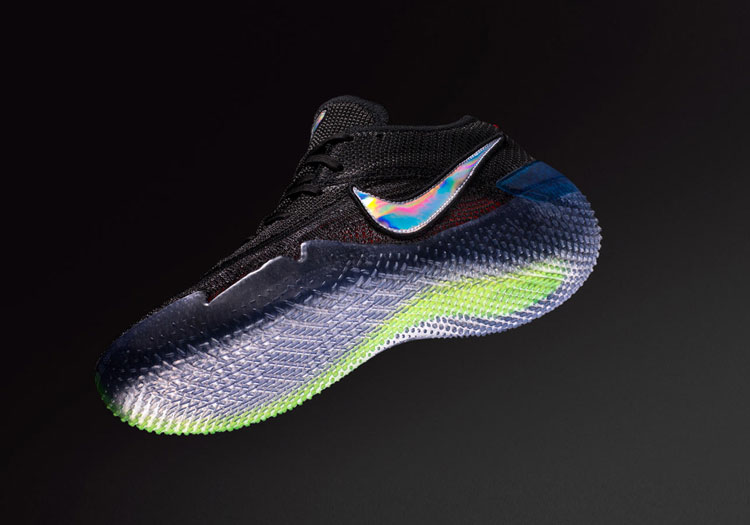London – Created on Stoll flat knitting technology, Nike's Flyknit system is to benefit from a new, London-based textile design laboratory, which will develop and explore new application technologies for functional footwear and apparel innovations.
Initially unveiled in February 2012, the technology has allowed Nike to create light, flat-knitted uppers with different structures for different areas in polyester yarn, with varying elasticity, thickness and strength. Now, Nike has told Dezeen that its new London studio will help further advance the application potential of such technologies.
Speaking about the opening of the London studio, John Hoke, president of global design at Nike, told Dezeen: "We're looking at waft, depth, materiality, and just trying new stuff. Through that trying we’re getting a lot of great things.
“The London [studio] is relatively new. We decided to be creative and open up a studio that lets our young British designers stay in their home country and explore and experiment," he added.
Nike recently made a major breakthrough in the development of its Flyknit footwear by digitally engineering the 360-degree construction of the shoe uppers. Created on Stoll flat knitting machines, the new design helps to create lighter, formfitting footwear whilst cutting back on waste by around 60 per cent.
Flyknit technology is said to have already redefined the development and creation of footwear with its ability to be engineered to provide a more precise fit for the specific needs of the foot. Using the latest flat knitting techniques, support and structure are knitted directly into items, which helps reduce seams, weight and areas of friction, and keeps the items lightweight.
When the Flyknit technology was first launched, the uppers were created by knitting a flat fabric that was then attached to the midsole to produce a conventional fitting shoe. Now, however, Nike is using the latest in digital technologies to pre-determine the mould of the entire, 3D knitted shoe upper which is then attached to the sole to offer a more secure fit. Engineers use complex knitting structures to achieve this, monitoring closely the anatomical form of the fabric and how it mimics the shape of the foot.
The shoe upper is then subjected to a process of thermoforming, which provides shape and support underfoot, enhancing breathability whilst offering a ‘second-skin feel’, the company claims.
“Because it completely wraps the foot, the construction offers a closer fit that locks the foot in to reduce in-shoe movement,” Nike says. “The 360-degree form is engineered for better movement and speed by allowing the shoe to move with the athlete by minimizing the space between the foot and the ground.
“In addition, Nike Flyknit is precision engineered down to every stitch, which produces 60% less waste than traditional cut-and-sew methods. The technology applies 40 years of athlete insights to inform the precise placement of support, flexibility and breathability where athletes need it most while minimising the impact on the environment.”
Recently, Flyknit technology has also expanded into the apparel category including the production of sports bras which, using the latest knitting techniques, has a reduced number of seams, weight and areas of friction. In 2017, the company also combined body-mapping design techniques with the latest flat knitting technology to create a capsule collection that uses performance data collected from athletes, resulting in high-performance garments that provide extra ventilation and coverage where needed.
Meanwhile, last month's Nike Innovation Summit was held to present new products that athletes will wear at this summer’s sporting events including the Rio 2016 Olympic Games and the UEFA Euro 2016 football tournament, plus other innovations including the ‘Nike HyperAdapt 1.0’ footwear which has self-tightening laces.
At the summit, Nike footwear designer Tinker Hatfield said the sneakers were not a gimmick and could help athletes perform better, and assist people with mobility issues who struggle to tie and untie their shoelaces.
As reported earlier this month by T.EVO, the company also recently launched a new range of functional garments and footwear which included a football boot to repel mud to reduce weight when worn in testing conditions. The company says that preventing mud from sticking to the bottom of football boots will “seriously improve the performance” of wearers.
The ‘Anti-Clog Traction’ sole, which has been in development stage for the last two years, has been described by Nike as an “adaptive polymer that becomes compliant when exposed to water” – essentially making the boot’s sole slippery enough to repel mud without impacting on performance.
"We stopped thinking about repelling water and started thinking about using it to our advantage to create a lubricious layer, without sacrificing traction," said Jeremy Walker, senior materials developer at Nike.
"Understanding the molecular structure of mud was key to developing a hydrophilic solution, which helps keep mud from clogging the plate."
